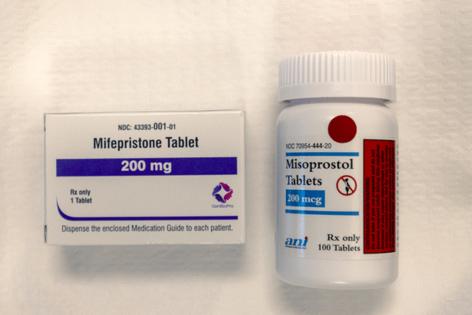Lisa Jarvis: The FDA's mifepristone decision has baffled both sides
Published in Op Eds
The Food and Drug Administration’s recent approval of a second generic version of the abortion pill mifepristone has left people on both sides of the reproductive rights fight scrambling to interpret the decision. Could this be a sign that the Trump administration isn’t interested in taking federal action to further restrict abortion access?
Their intense search for meaning behind an otherwise routine regulatory decision illustrates the high anxiety over the future of a drug that is crucial for abortion access in the U.S. — not just for women in states with bans, but for women everywhere.
In reality, nobody knows what the FDA’s approval signifies — if it signifies anything at all. What we do know is that antiabortion groups are capitalizing on the moment to increase pressure on the Trump administration to take more decisive action on mifepristone. It’s become another talking point in their relentless campaign to make it harder for women to access the drug (ideally, they’d like it taken off the market) and another opportunity to spread misinformation about its safety.
“The only thing we know for sure is that the antiabortion movement is charging ahead on multiple fronts,” says Greer Donley, a University of Pittsburgh law professor who studies abortion law.
After the Supreme Court overturned Roe v. Wade in 2022, mifepristone — part of a two-drug regimen that can be used to terminate a pregnancy up to 11 weeks — became essential to maintaining abortion access amid the rapid spread of state-level bans. That’s because the FDA had recently relaxed its rules about how the pills could be prescribed and dispensed, allowing women to receive them by mail after a telehealth visit with a provider.
In 2023, the most recent year for which data are available, mifepristone accounted for about 63% of abortions in the US. By the end of 2024, one in four abortions was accessed via telehealth, according to the Society of Family Planning. About half of those telehealth services were offered under state “shield laws,” which protect providers who prescribe pills to women living in states with bans or tight restrictions on the procedure.
The pill is also vital for women in states where abortion remains legal. Telehealth has offered a more accessible option than in-person care for women who live far from a clinic or whose circumstances might make a doctor’s visit difficult. That’s become even more important as Planned Parenthood affiliates grapple with a new law that bars clinics from receiving Medicaid funding for any health care services if they also provide abortions. After the law went into effect on Oct. 1, Planned Parenthood clinics in Wisconsin — where the procedure is legal — suspended abortion services. Meanwhile, clinics around the country are closing or scaling back services in the face of funding cuts, further limiting women’s options for in-person care.
Of course, antiabortion groups would love to see that trend grow. So far, they’ve compelled the FDA to announce a review of mifepristone’s safety, though the agency hasn’t provided a timeline for its completion.
The approval of a second generic mifepristone has triggered fury among activists. Almost every Republican senator signed a letter demanding the FDA reconsider its approval and reinstate in-person dispensing requirements. Former Vice President Mike Pence wrote an op-ed in the Wall Street Journal criticizing the FDA and the Trump administration — one of several opinion pieces that spread false claims about the pill’s safety.
The goal of antiabortion activists is twofold: to pressure Trump into taking action and to confuse women about whether medication abortion is legal or safe. This is despite consistent data across many years — including telehealth prescriptions — showing it is both safe and effective.
In tandem with this pressure campaign is a renewed push to convince the courts that the FDA overstepped its authority in allowing mail-order access to the drug. The latest case is led by Louisiana Attorney General Liz Murrill, who has tried to prosecute out-of-state providers for prescribing the drug to residents in her state. She argues that shield laws impede the enforcement of Louisiana’s abortion ban by protecting out-of-state doctors who mail pills to women, explains Mary Ziegler, a University of California, Davis, law professor specializing in abortion law. A woman who says she was coerced into taking abortion pills by a boyfriend who bought them from a provider in California has signed on as a plaintiff, Ziegler adds.
Murrill is attempting a new spin on a suit against the FDA brought by a group of Texas doctors who also wanted the agency to restore previous restrictions on the pills, including requiring in-person visits, and rescind the policy allowing mail-order access. That case reached the Supreme Court, which dismissed it on technical grounds.
Reproductive law experts say Murrill is unlikely to fare any better than the Texas doctors.
Anyone tempted to feel reassured by the Trump administration’s lack of action on mifepristone — to interpret it as a sign of disinterest in changing the status quo — should take a step back. Antiabortion groups are clearly convinced that one of their many legal or regulatory challenges will eventually succeed — and we should worry that eventually they will find a case that does.
And in the meantime, the confusion, fear and misinformation they’re spreading could be deterrent enough. Women should know that, for now at least, this safe and effective form of health care is still available.
_____
This column reflects the personal views of the author and does not necessarily reflect the opinion of the editorial board or Bloomberg LP and its owners.
Lisa Jarvis is a Bloomberg Opinion columnist covering biotech, health care and the pharmaceutical industry. Previously, she was executive editor of Chemical & Engineering News.
_____
©2025 Bloomberg L.P. Visit bloomberg.com/opinion. Distributed by Tribune Content Agency, LLC.
























































Comments